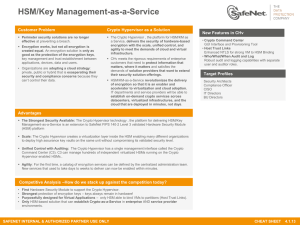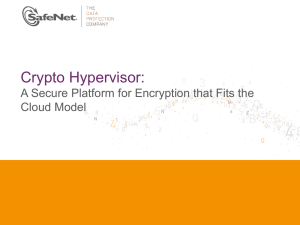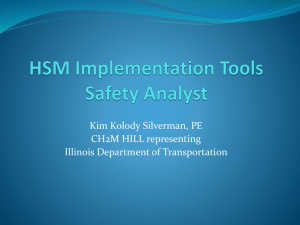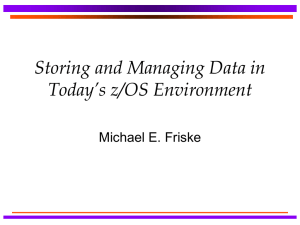Crypto Hypervisor Technical Sales Presentation
advertisement
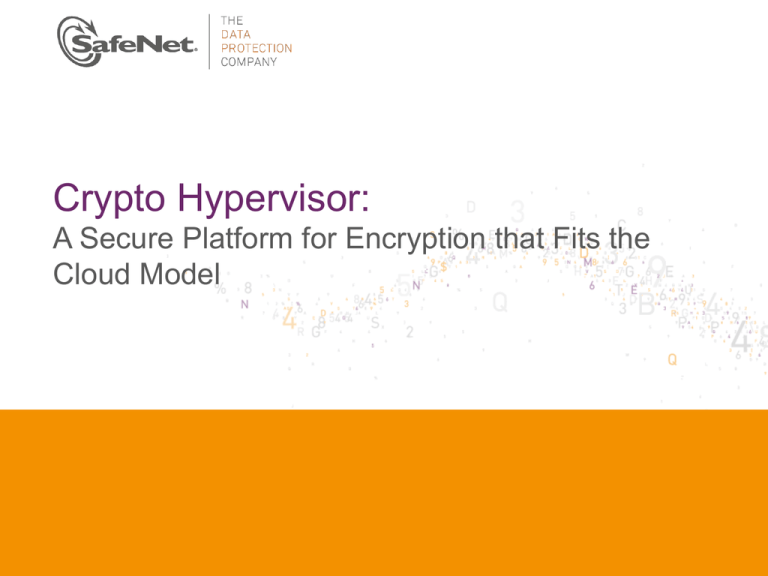
Crypto Hypervisor: A Secure Platform for Encryption that Fits the Cloud Model Insert Your Name Insert Your Title Insert Date Who We Are Trusted to protect the world’s most sensitive data for the world’s most trusted brands. We protect the most money that moves in the world, $1 trillion daily. We protect the most digital identities in the world. We protect the most classified information in the world. FOUNDED OWNERSHIP 1983 Private REVENUE GLOBAL FOOTPRINT ~330m +25,000 Customers in 100 countries EMPLOYEES ACCREDITED +1,400 Products certified to the highest security standard In 25 countries A Hardware Security Module is… …a dedicated Hardware crypto processor… …designed for Hardware protection of the crypto key lifecycle… …validated to be secure by third parties… …a “Trust Anchor”… Crypto Hypervisor uses Hardware Security Modules as the hardware platform Dynamic Crypto Resource Crypto Hypervisor Hardware Security Module 4 Crypto Hypervisor Extends the Capability of HSMs to Fit the Cloud Model NIST1 Cloud Definition of Essential Characteristics Legacy HSMs NIST1 Cloud Definition of Essential Characteristics Crypto Hypervisor On-Demand Self-Service No On-Demand Self-Service Yes Rapid Elasticity No Rapid Elasticity Yes Measured Service Yes Broad Network Access Yes Resource Pooling Yes Multi-Tenancy2 Yes Measured Service Broad Network Access Resource Pooling Multi-Tenancy2 1. 2. Some Yes Some No National Institute of Standards and Technology Multi-Tenancy is an essential characteristic added by the Cloud Security Alliance 5 Crypto Hypervisor: Designed for operational cloud model 1 On-demand crypto delivery 6 Apps can now migrate to cloud 2 Self-service portal for users 5 Part of “New VM Rollout Process” 3 New crypto services spin up easily 4 Encryption now a cloud enabler 6 Three things to know about Crypto Hypervisor Built for the cloud • Shared resource pooling, rapid elasticity and multitenancy • Can reduce capital costs up to 95% Lower TCO • Take advantage of virtualization • Deliver high-assurance cryptographic resources in a fraction of the time • 5 minutes, not 5 hours Centralized control • Strong auditing capabilities • Compliance in the Cloud • Ensure enterprise-wide consistency of crypto policy 7 Use Case: Enterprise BEFORE: Encryption protects many apps Islands of encryption Problems: Costly Complex mgmt/admin Requires expertise to deploy crypto New encrypted app rollout is inefficient DNSSEC SSL © SafeNet Confidential and Proprietary Database Email AFTER CHv: CHv: platform for all encryption Consolidated to CHv-managed virtual HSMs Benefits: Cost savings (hardware) Simplified mgmt/admin Policies enforced consistently New encrypted app rollout is fast (minutes vs. hours) Code Sign 8 Solution Highlights Host Trust Link (HTL) securely binds virtual applications to dynamic crypto resources Prevents Stolen VM from Accessing Critical Assets Crypto Command Center Simplifies HSM management, through Abstraction of HSM Hardware Publish Catalogs for on-demand service Separation of roles/responsibilities in multi-tenancies Built on proven platform Availability: Five 9’s uptime, robust high availability Validated Security: FIPS 140-2 Level 3 and CC EAL 4+ HW Trust: Keys remain in Hardware! Who/What/When Auditing and Logging Configurable based on your Organizational needs Control: Unique Roles for Security in Multi-tenant Environments. System administrators: manages physical devices (appliances, expansion cards, etc.), and provision access to resource catalogues for users. Consumer/User: manage crypto applications that consume crypto services. Own their HSM resource when ‘leased’. 9 What’s in the Crypto Hypervisor SafeNet Luna SA 5.2 HSM Crypto Command Center Bundle Includes: • Crypto Command Center Software • SafeNet Luna G5 • Local PED II • PED II Keys Crypto Command Center SafeNet PED II SafeNet Luna G5 Feature: Crypto Command Center 11 What is Crypto Command Center? System (SW) to automate the provisioning of HSM resources Abstracts the management of HSMs from the end user Administrators • • • • • Consumers/Users • • • • Manage the crypto for your company Manage the physical HSM devices Determine what crypto services are offered Create a catalog of services for end users Manage who has access to those services Manage crypto applications that consume crypto services Own their HSM resource when ‘leased’ Request and release use of HSM resources from catalogues Always in control of their keys! Implements REST-ful API or GUI (web based) interfaces (Next Release) 12 Why Use Crypto Command Center? Trust • Save Money • Remove the Management burden from your Application owners Scale • Leverage the HSM resources to their Fullest Ease of Use • Centralize your Organizations Cryptographic Trust HSM Infrastructure that Scales as your demand grows Enforce policy and Governance • Provide Cryptographic Trust Anchors that enforce centralized corporate policy and governance 13 Crypto Hypervisor Enables Crypto as a Service either on Premise or in the Cloud! Consumer Crypto Admin Crypto Command Center SSH Crypto Application + Luna Client Luna SA Device Pool Crypto Command Center Terminology Service • A catalog Item becomes a Service once deployed Organization HSM End User Device Pool Device – Luna SA - 1 Device – Luna SA - 2 Device – Luna SA - 3 System Catalog Clone, High Perf, FIPS2, 2MB Key Extraction, FIPS2, 1MB Clone, Low Perf, FIPS2, KCDSA Service 15 Crypto Command Center - Demo Architecture Jameson Corp New York SJames Crypto Apps SA 7000 1 (PED, Cloning) Clone, High Perf, FIPS3, 2MB SA 1700 1 (PW, Cloning) Key Extraction, FIPS2, 1MB SA 1700 1 (PED, Key Export) Clone, Low Perf, FIPS2, 2MB SA 7000 1 (PW, Cloning) System Device Type SA Appliance Code Signing HSM admin Role sjames Capabilities •Performance (H/L) •Backup (Clone) •Authentication (PWD) •Storage size (2MB) 16 Crypto Command Center – Indirect Login Luna G5 is initialized as normal Upon first “admin” login to CCC • RSA-2048 key pair is generated on G5 • AES-256 key is generated on G5 • AES Key used to encrypt Appliance Admin password (stored in DB) “admin” registers a device When “admin” initializes the device… • The SO password\PED is supplied during initialization • The “public” key from the G5 is copied to the SO partition on the device (Luna SA) • HA_Init is called on the device (Luna SA) 17 Crypto Command Center – Indirect Login Indirect Login procedure… 1. 2. 3. 4. 5. 6. 7. 8. “Token Wrapper Cert” (TWC) created on G5 TWC sent to Luna SA Luna SA wraps a “challenge” with TWC Wrapped “challenge” sent to G5 G5 “unwraps” the challenge with Private Key G5 generates a challenge response Challenge response is sent to Luna SA Luna SA confirms challenge response (valid\invalid) 18 Crypto Command Center – Indirect Login No HSM token or domain information is stored in the database Indirect Login occurs when… • CCC admin initializes a device • Consumer initializes and releases a service 19 Feature: Host Trust Links 20 Host Trust Link What is it? • “Host Trust Link” • Works on Virtual Machines and traditional OS systems Why Use it? • Trust • Virtual Machines are meant to be portable • HTL protects against a Stolen VM accessing your HSM resources • Ease of Use • Built into HSM client registration process 21 VM is Stolen…VMs with “HTL” Host Trust Link • • • • Prevents theft of an at-rest VM image Connection to the SA is authorized by a one-time token Includes a step counter that must sync with the SA NTLS depends on an active HTL connection HSM Client VM NTLS X Access Denied Luna SA Today: • Stolen VM will not be granted access to SA partition • Stolen image does not have OTT, required to establish HTL Link HTL … More info Can multiple client systems with same HTL security credentials operate simultaneously? • No – only first HTL connection will be authorized, all subsequent will be rejected OTT details: • RNG from FIPS validated HSM • OTT bound to specific client (leverages client registration details) • OTT details stored in client system RAM Once HTL is established – how is the trust maintained? • Sync beacon (counter) created by HSM • Client required to send beacon back to HSM to maintain HTL link Sync Beacon details: • Grace Period (period after beacon has NOT been received) • • • • Default 60 seconds Configurable 0-10+ minutes Allows for existing OTT to be re-established (within Grace period) If Grace period surpassed, OTT regen and administrative step for reconnection required 23 HTL … More info What is required when a VM is moved, in a trusted environment: • Assuming Client registration details are the same (Certs/IP/etc) • HSM Admin: • Regen OTT • Push OTT to new target VM HTL and NTLS (network link) • NTLS requires validated HTL Connection • • Wont start And Will be actively ‘torn down” What does HTL Bind to: • Client IP • Client OTT Why not Bind to physical Machine attributes: • Not available via standard mechanisms exposed via VM 24 Host Trust Link Configuration required on SA and Client side HTL configuration is on a per client basis • Single client configured for two Luna SA appliances • Need to configure HTL for both members 25 Host Trust Link HTL Setup • • • • On SA, configure client to require HTL On client, configure to require HTL On SA, generate OTT On client • Copy (scp) from Luna SA • Move to HTL folder • C:\Program Files\Safenet\LunaClient\htl • /usr/safenet/lunaclient/htl 26 Feature: Secure Audit Logs 27 Why log? Want to be able to Audit all HSM operations • Who/What/When? • Was the operation a Success or Failure? Want to ensure the Origin of the logs • Messages come from this HSM Want to ensure the Integrity of the logs • No Alterations • No Deletions • No Truncation Meet Audit and Compliance Mandates © SafeNet Confidential and Proprietary 28 What Gets Logged – Categories Critical • Tamper, HSM init, Audit init, Zeroize • Always logged HSM Management • change password, create challenge, change policies HSM Access • Login/Logout Key Management • key creation/deletion Key Usage • use of key for crypto ops (‘First Use Only’ flag) External • CA_LogExternal API messages Log Management • Log management related commands (import/export secret, verify) © SafeNet Confidential and Proprietary 29 How it works “HMAC chain” • Each log record signed with SHA256 HMAC • HMAC calculated from • Previous record HMAC • Internal log secret • Log secret is set at manufacture and generated during first powerup • Current event data • Most recent HMAC saved to NVRAM • Logged to internal HSM memory • Logging Daemon • Signed log record offloaded to host © SafeNet Confidential and Proprietary 30 Verification Submit sequence of signed log records • Include HMAC of final message • HSM recalculates HMAC chain • Compares to received Origin • Log secret unique to HSM Integrity • HASH chain must match Can verify on other HSMs Log secret can be exported to another Luna SA to enable log validation © SafeNet Confidential and Proprietary 31 Audit Role Independent of Security Officer • Audit config is preserved over HSM init and Factoryreset • White key for FIPS L3 (Associated with Domain key) Audit user: • Set event categories/conditions • Sync system time • Verify logs SO: • Verify system logs © SafeNet Confidential and Proprietary 32 Audit Logging Audit logging is separate from traditional logging • Audit logging must be initialized and configured • Can be done anytime • init, tamper, zeroize, audit role creation are always logged… log file can’t be accessed unless “audit” role exists 33 Audit Logging Time used for log is UTC Audit role has ability to sync time (manually) between the HSM and CLIENT Syslog server can be used • UDP or TCP supported • Port can be customized 34 Performance Impact Logging requires crypto operations • Logging serializes command execution • HMAC calculation Tradeoff – performance vs. amount logged Reduce impact • Only log necessary data • “First Use” modifier for key usage logging © SafeNet Confidential and Proprietary 35 Other Features 36 Common Client Common Client For SA/PCI-E/G5 • One install package • Choose products/features • Including remote PED and remote Backup • Choose APIs • PKCS#11, Java, JCProv, Microsoft CSP,KSP • Choose Production or Development • SDK and samples 37 Common Client Enhanced OS Support • • • • • Windows 2008R2, 2012 Linux (RedHat 5, 6, SUSE 10, 11, Debian 6) Solaris 10,11 AIX 6.1, 7.1 HP-UX 11iv3 (11.31) 38 Remote Backup Improvements Backup to remote Backup HSM Simplified with remote PED! Don’t need to configure backup HSM to be a client of the partition! 39 Remote Backup Improvements Configuration • Install RBS (Remote Backup Service) • Part of Luna client install • Generate RBS cert • Copy cert to client • ‘vtl addserver’ • Now backup HSM shows as a network slot Backup • ‘lunacm partition backup’ • Set target slot as remote backup slot 40 Remote Backup – High Level Architecture Client Server Luna CM 1 SSH Crypto App System Admin PED Server 4 2 3 1. SSH/RDP to Client 2. Setup rPED to SA and Login to Partition 3. Setup rPED to RBS 4. Lunacm>par backup Remote Backup Server PED Client RBS Backup HSM 41 Other JCProv • Java-PKCS#11 API Upgradable PED • Any PED with FW 2.4.0-3 can be upgraded • Need to upgrade for Audit logging • Can’t change between Local and Remote PED 42
